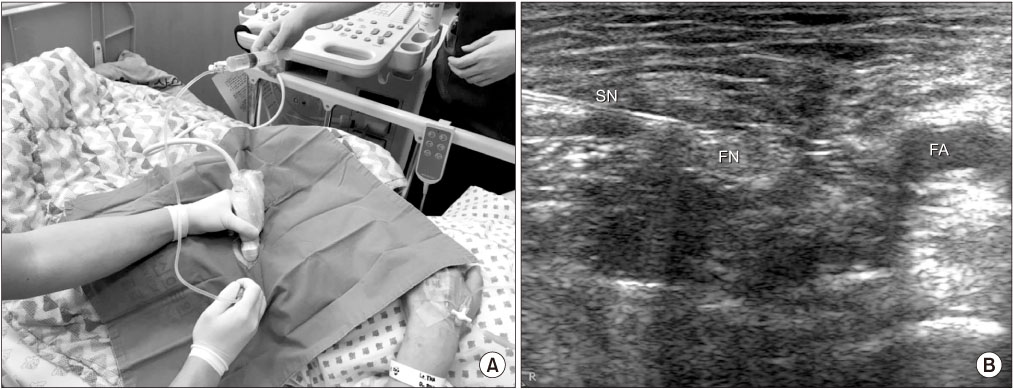J Korean Orthop Assoc.
2018 Jun;53(3):243-247. 10.4055/jkoa.2018.53.3.243.
A Comparison of the Results from Femoral Nerve Block Using Different Concentration of Ropivacaine after Total Knee Arthroplasty
- Affiliations
-
- 1Department of Orthopedic Surgery, Busan Medical Center, Busan, Korea. jun4128@naver.com
- KMID: 2429172
- DOI: http://doi.org/10.4055/jkoa.2018.53.3.243
Abstract
- PURPOSE
Peripheral nerve block is one of the many options available to reduce pain after total knee arthroplasty. Among the various kinds of peripheral nerve block procedure, femoral nerve block (FNB) using ropivacaine is a very effective method for reducing pain. However, it has been known to cause weakness in the quadriceps femoris, resulting in an increased risk of fall during ambulation after surgery. The purpose of this study was to compare the effectiveness of FNB on pain and muscle strength with different concentrations of ropivacaine.
MATERIALS AND METHODS
Our study was performed on 120 patients with knee osteoarthritis who had undergone total knee arthroplasty between January 2016 and December 2016. Patients were divided to 3 groups depending on the concentration of ropivacaine: Group 1 received 0.125% ropivacaine 6 ml FNB; group 2 received 0.2% ropivacaine 6 ml FNB; group 3 received normal saline 6 ml FNB. FNB with 1% lidocaine 10 ml and 0.75% ropivacaine 10 ml was performed to all groups at 3 hours after surgery. From the day after surgery, each group of patients were injected 4 times with FNB on their own designated concentration of ropivacaine with an interval of 6 hours. The severity of pain was estimated by visual analogue scale (VAS) and the strength of quadriceps femoris was measured using medical research council (MRC) grade and knee extension angle.
RESULTS
VAS score in group 3 was significantly higher compared to other groups; MRC grade in group 2 was significantly lower than in other grades, and knee extension angle in group 2 was significantly lower than in other groups at 6 pm on the day of and at 6 am on the day after surgery. VAS score, MRC grade, and extension angle of all groups showed no significantly difference at other times.
CONCLUSION
FNB with 0.125% ropivacaine after total knee arthroplasty shows effective reduction of pain without inducing quadriceps femoris weakness.
MeSH Terms
Figure
Reference
-
1. Fishman S, Ballantyne J, Rathmell JP. Postoperative pain. In : Bonica J, editor. The management of pain. 2nd ed. Philadelphia: Lippincott Williams & Wilkins;1990. p. 461–480.2. Warfield CA, Kahn CH. Acute pain management. Programs in U.S. hospitals and experiences and attitudes among U.S. adults. Anesthesiology. 1995; 83:1090–1094.3. Miller RD. Anesthesia. 6th ed. New York: Churchill Livingstone;2004. p. 417–487.4. Mahoney OM, Noble PC, Davidson J, Tullos HS. The effect of continuous epidural analgesia on postoperative pain, rehabilitation, and duration of hospitalization in total knee arthroplasty. Clin Orthop Relat Res. 1990; (260):30–37.
Article5. Parvataneni HK, Ranawat AS, Ranawat CS. The use of local periarticular injections in the management of postoperative pain after total hip and knee replacement: a multimodal approach. Instr Course Lect. 2007; 56:125–131.6. Jaeger P, Nielsen ZJ, Henningsen MH, Hilsted KL, Mathiesen O, Dahl JB. Adductor canal block versus femoral nerve block and quadriceps strength: a randomized, double-blind, placebo-controlled, crossover study in healthy volunteers. Anesthesiology. 2013; 118:409–415.7. Beebe MJ, Allen R, Anderson MB, Swenson JD, Peters CL. Continuous femoral nerve block using 0.125% bupivacaine does not prevent early ambulation after total knee arthroplasty. Clin Orthop Relat Res. 2014; 472:1394–1399.
Article8. Flandry F, Hunt JP, Terry GC, Hughston JC. Analysis of subjective knee complaints using visual analog scales. Am J Sports Med. 1991; 19:112–118.
Article9. Medical Research Council. Aids to examination of the peripheral nervous system. Memorandum no. 45. London: Her Majesty's Stationary Office;1976.10. Paul JE, Arya A, Hurlburt L, et al. Femoral nerve block improves analgesia outcomes after total knee arthroplasty: a meta-analysis of randomized controlled trials. Anesthesiology. 2010; 113:1144–1162.11. Liu SS, Ware PD, Allen HW, Neal JM, Pollock JE. Dose-response characteristics of spinal bupivacaine in volunteers. Clinical implications for ambulatory anesthesia. Anesthesiology. 1996; 85:729–736.
- Full Text Links
- Actions
-
Cited
- CITED
-
- Close
- Share
- Similar articles
-
- Effect of Regional Nerve Block in Total Knee Arthroplasty
- Analgesic effect of ropivacaine with fentanyl in comparison with ropivacaine alone for continuous femoral nerve block after knee replacement arthroplasty: a prospective, randomized, double-blinded study
- Comparison of the Effect of Continuous Femoral Nerve Block and Adductor Canal Block after Primary Total Knee Arthroplasty
- The relative analgesic value of a femoral nerve block versus adductor canal block following total knee arthroplasty: a randomized, controlled, double-blinded study
- A comparison of continuous femoral nerve block combined with sciatic nerve block and epidural analgesia for postoperative pain management after total knee replacement


